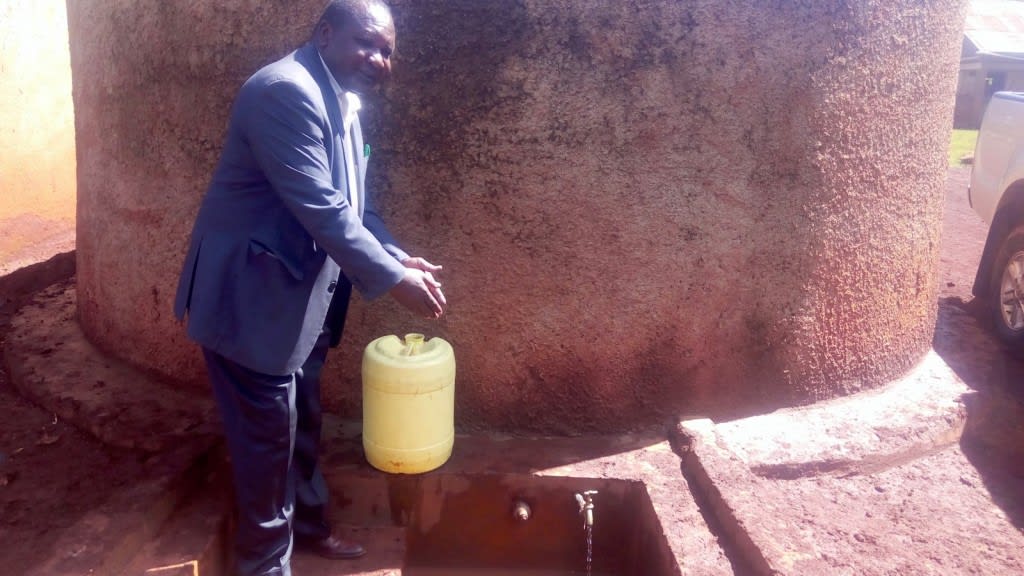This project is a part of our shared program with Western Water And Sanitation Forum (WEWASAFO). Our team is pleased to directly share the below report (edited for clarity, as needed).
Background Information
Situated in Kakamega County, Bukhungu Location, Shirere Ward of Kakamega Central, the school was started on May 2, 1989 by Mr. Fred Anguba, who is still the head teacher. The school began with a total of six teachers and 36 pupils. Before Mr. Anguba's school, long before Kenya's independence, the facility was host to government employees working for the District Commissioner's office. After Kenya's independence in 1963, locals converted the building into a bar.
When local brews were banned by the former president, Daniel Torotich Arap Moi in 1989, the brew den was closed down, leaving the structures abandoned. The community thought it wise to convert the facility into a school, "Amalemba Primary School." The school is sponsored by Pentecostal Assemblies of God.
Amalemba Primary School has a total student population of 1,177. The primary section has 536 boys and 551 girls, totaling 1,087. The Early Childhood Department has 42 boys and 38 girls, totaling 80 students. Finally, the special needs unit has four boys and six girls. (Editor’s Note: While this many people may have access on any given day, realistically a single water source can only support a population of 350-500 people. This site would make a great location for a second project. To learn more, click here)
The Current Source
There is no water source within the school compound. A plastic water catchment tank of a 2,000-liter capacity was blown away by the wind, leaving the school with nothing. The pupils therefore have to carry water from home to school every morning. This water is not enough to serve the entire school, and early education children can only carry half-a-liter jerrycans due to their small frames. The head teacher, Mr. Anguba, admitted that getting water is the school's biggest challenge.
This school will greatly benefit from a new, larger rainwater catchment tank.
Sanitation Situation
The school has a total of 30 VIP latrines. Of the total, teachers have two doors, girls have 16, and boys have 12. Considering the above statistics, this is falling far below the UNICEF standards of sanitation, which recommends one door per 25 females and one per 30 males. Since the school has 5.9 acres of land, there is enough space to construct more VIP latrines. Parents have already voiced their support and willingness to contribute to this project's sustainability.
WEWASFO has qualified Amalemba Primary School for a project because it is deserving and willing to contribute time, effort, and locally-available materials.
Project Results: Training
Hygiene and sanitation training was held in one of the school classrooms from February 10-11. The head teacher was notified of the schedule ahead of time so that he had time to invite both teachers and pupils. Attendance was good, with a mix of men and women, and children of different ages. There was active participation with students eager to learn.
A range of topics were covered, including:
- Primary healthcare
- Community-Led Total Sanitation
- CTC club (child to child)
- Project sustainability
- Hand-washing
The facilitator used group discussions, role-plays, lectures, brainstorming, on-site training, demonstrations and pictures to teach the above topics and more.
By the end of training, a CTC club for the school was successfully assembled and trained. Participants also agreed on specific days for the club to meet. These meetings are purposed for the sharing of the students' knowledge of hygiene and sanitation. The training participants were also assigned responsibilities, such as maintaining the hand-washing stations and water point. CTC Club President Sophie Ogutu said, "I didn't know how to wash my hands properly. From this training, I have learned how to do it pretty well and I know I will keep germs at bay and stay healthy. I will also teach my siblings and parents the ten hand-washing steps."
VIP Latrines: Construction of two triple-door VIP latrines is complete and are now in use.
Hand-Washing Stations
Two hand-washing stations were delivered and installed, and are now in use by students. Because of the pupils’ training on proper procedures for hand washing, both boys and girls alike are happy to was hands and demonstrate their knowledge for others.
Rainwater Catchment Tank
Construction for the 30,000-liter rainwater catchment tank began on January 10th. The process began with site clearance, setting and casting the foundational slab, construction of the wall, roofing, and installation of fittings such as delivery pipes, vent pipes, and screens. Finally, good drainage was ensured.
The community provided many materials that were used to build the structure, such as bricks, sand, hardcore, ballast, sugar sacks, and poles. The school also made sure that the construction team was taken care of well, providing both meals and accommodation.
Lack of water was a challenge during tank construction, which delayed the project at least four weeks. Once the project was finally complete, Head Teacher Anguba O. Fred said, "This project is a great blessing for us. Pupils have been suffering a lot especially when they want water for drinking. Most of them would just take any water available to quench their thirst, thus subjecting them to waterborne diseases. This tank has solved all those cases in this school."
Thank You for unlocking potential for the students of Amalemba Primary School!

 Rainwater Catchment
Rainwater Catchment
 Rehabilitation Project
Rehabilitation Project























